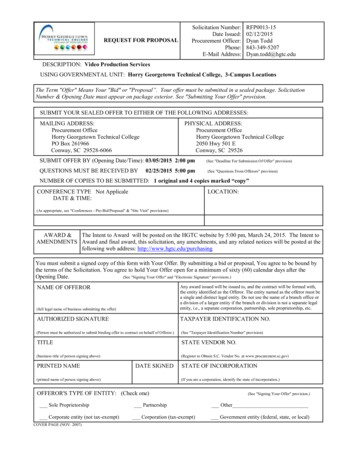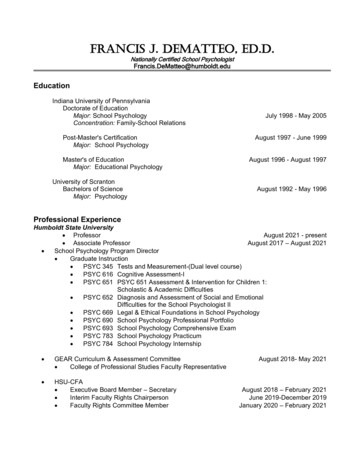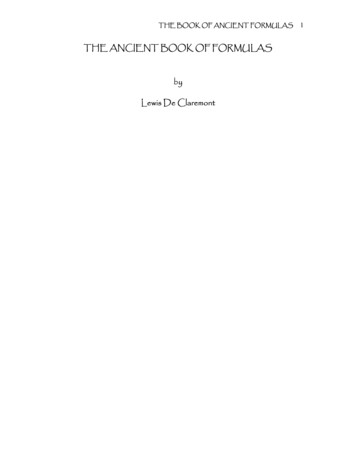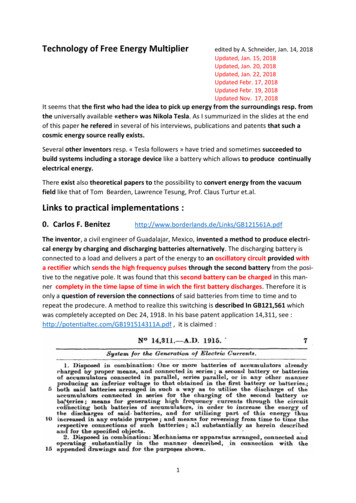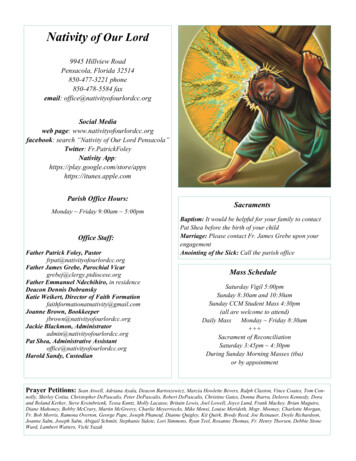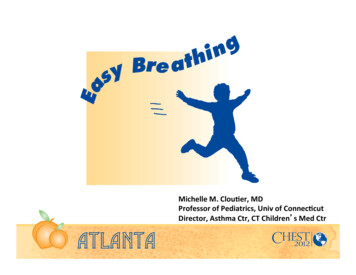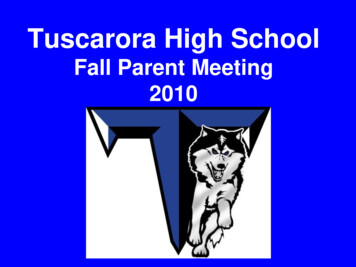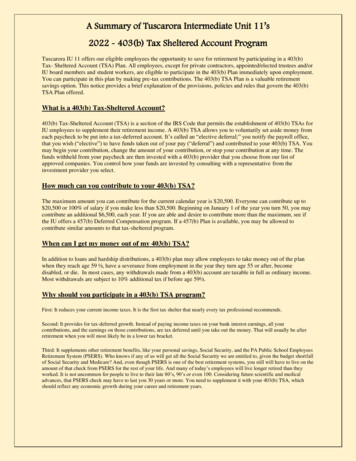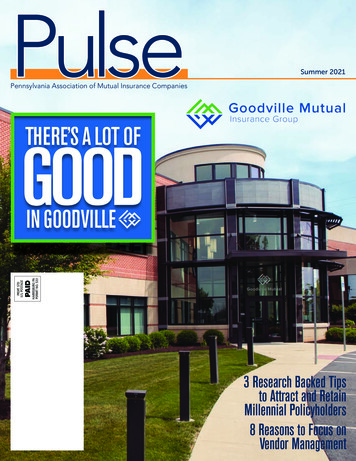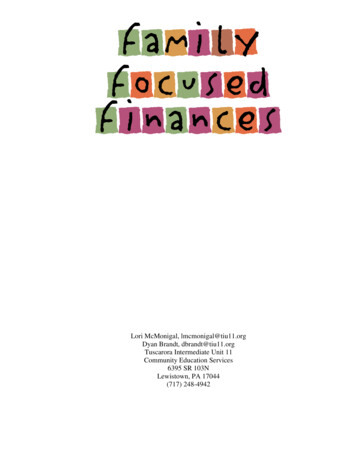
Transcription
Lori McMonigal, lmcmonigal@tiu11.orgDyan Brandt, dbrandt@tiu11.orgTuscarora Intermediate Unit 11Community Education Services6395 SR 103NLewistown, PA 17044(717) 248-4942
The Tuscarora Intermediate Unit was awarded a COABE Incentive Grant to develop Family FocusedFinances in 2006-2007. The goal of the project was to design a curriculum to address the financialchallenges facing families living in, or on the brink of, poverty. The intent of the product is to increasethe participants’ financial literacy in an effort to impact their future economic success. The curriculumthat follows is the product of the COABE Incentive grant. The Tuscarora Intermediate Unit gratefullyacknowledges COABE's support of this initiative.Electronic copies of this curriculum can be obtained by contacting TIU staff at:Lori McMonigallmcmonigal@tiu11.orgDyan Brandtdbrandt@tiu11.orgThe activity, which is the subject of this resource, was supported by COABE. However, the opinionsexpressed herein do not necessarily reflect the position or policy of COABE or the PA department ofEducation and no official endorsement should be inferred.
Family Focused Finances was developed with financial support from the Coalition on Adult BasicEducation as an incentive grant. The intended audience for the curriculum is adults participating in afamily literacy program. However, the material is relevant to any adult. The goal of the curriculum is toincrease the participants’ awareness of financial topics.The curriculum is divided into six units developed around the Equipped for the .pdf) and Workplace Foundation foundationskills/FS Wheel.pdf) curriculum frameworks.Each unit consists of the following: Key Vocabulary; Journal Topic; Activities; Self Reflection; andInteractive Literacy Activities for parents and children. A knowledge based pre test and post test is alsoprovided to determine success. The curriculum is organized such that each unit contains an outline,lesson plans, and handouts.
Key Vocabulary ListsDaily Journal FormReflection Journal
VocabularyUnit 1Identifying yed Gratification
VocabularyUnit 2Managing Your ResourcesBudgetIncomeGross IncomeNet IncomeTaxesFixed ExpensesVariable Expenses
VocabularyUnit 3Establishing a Bank AccountChecking t
VocabularyUnit 4Being Clever with CreditFinance chargesInterestRevolving CreditBalanceMinimum Monthly PaymentCredit LineLate feesDefaultCredit Report/ Credit Rating
VocabularyUnit 5Planning AheadAllowanceUnexpectedDeductible
VocabularyUnit 6Putting It All TogetherProblemSolutionConsequence
Daily Journal FormTopic:My Response
A Penny for Your Thoughts!Reflection JournalA money habit I currently have that I am proud of is:Something I learned today that I might consider trying:
Key Vocabulary: Needs: of necessity (Necessity meaning “the condition of being essential or indispensable”)Wants: that which is desired; a thing of which the loss is felt; what is not possessed, and isnecessary for use or pleasureValues: beliefs of a person or social group in which they have an emotional investment(either for or against something)Gratification: that which affords pleasure, satisfaction, enjoyment; a rewardDelayed: caused to be slower or laterDelayed Gratification: a delay in that which affords pleasure, satisfaction, etc.Goals/ Outcomes: Differentiate between needs and wants.Describe how values can influence decisions.Examine how values-based decisions can impact financial goals.Equipped for the Future and Workplace Foundation Skills:Equipped for the Future: Demonstrates Self Management Strategies; Understands Finances; MakesDecisionsWorkplace Foundation Skills: Solve Problems and Makes Decisions; Reflects and Evaluates; ObserveCriticallyJournal Topic:You buy a lottery ticket and win 100! Will you spend it or will you save it? What are you going to doand why?Materials Needed:Family Focused Finances Pre SurveyKey Vocabulary WorksheetJournal FormHandout 1: Values and SpendingSpending TrackerReflection Journal
Activities:1. Welcome and Introductions: Welcome students to the six-session workshop on “Family FocusedFinances.” Over the next six sessions, we will be discussing financial topics such as identifyingpriorities, designing a budget, using bank accounts, selecting credit cards, and planning ahead forthe future. The final session will allow for continued discussion and reflecting on possibleapplications. Take time to introduce those participating in the session.2. Complete Family Focused Finances Pre Survey: This survey will serve as a baseline for thecourse and will be helpful to the instructors to see if knowledge is gained because of theinformation shared.3. Key Vocabulary: Preview together. Definitions can be brainstormed individually or as a group.If time permits, vocabulary words can be written on the board ahead of time, and students canuse dictionaries to locate words and write down the definitions prior to vocabulary review.4. Journal Writing: Have participants write freely about the topic, using the Journal Form, and, ifcomfortable, share their responses.5. Values and Spending: Share Handout 1 with students and give them a few moments to complete.Follow the directions on how to tally their answers.6. Debriefing: Discuss reactions to the activity. Was anything surprising?7. Homework Assignment: Introduce the sheet titled, “Spending Tracker.” Ask students tocomplete the form between this session and the next, and bring the completed sheet with them tothe next session to review.8. Reflection: Participants reflect on what they learned in the workshop using the ReflectionJournal.Interactive Literacy Activities:Related Children’s Literature:Bunny Money by Rosemary Wells, Rachel Axler (Editor)Max and Ruby take a trip to purchase the perfect birthday gift for their grandma – but they run into someunexpected expenses along the way!Activity:Potatoes and Gravy Game – Parents can talk to older pre-school and school age children about thedifference between needs and wants. “Potatoes” represent food, something we need to survive.“Gravy,” on the other hand, is just an added something that makes potatoes taste better. We may wantgravy, but we don’t necessarily need it. This game can be played by simply talking together, especiallywhen out shopping, or by looking through magazines or books and cutting out different pictures.Younger children may just enjoy looking for pictures and naming the objects. What a great way tointroduce new vocabulary! Another great way to illustrate this would be to serve mashed potatoes andgravy with families.Resources:Definitions found at www.webster-dictionary.orgValues and Spending found at NEFE:http://www.nefe.org/hsfppportal/files/23050 All%20of%20Unit%20Three.pdfThe “Potatoes and Gravy” idea was found at Practical Money Skills for t home/parents/lesson index.php?id 77
Lesson Plan for Unit 1Identifying PrioritiesTopicPre SurveyKey VocabularyPlan1. Independently,participants complete thepre survey.1. Review the keyvocabulary participants willuse in the workshop.Journal Writing:You buy a lottery ticket andwin 100! Will you spend itor will you save it? Whatare you going to do andwhy?MaterialsPre SurveyKey Vocabulary WorksheetJournal FormValues and Spending Habits 1. Complete Handout 1.2. Debrief- discuss results.What was surprising? Didyou learn anything newabout yourself?Handout 1:Values andSpending AssessmentHomework AssignmentSpending TrackerDebriefReflection1. Introduce the SpendingTracker.2. Explain use. Askparticipants to try thetracker for 1 week.Questions and DiscussionReflection Journal
Family Focused Finances- Pre Survey1. I am able to create and track a family budget.1 I am not able to do this.2 I could do this with some help.3 I am able to do this on my own.2. I can explain the difference between gross income and net income.1I am not sure of this.2I think I know this.3I am sure of this.3. I can explain at least three risks and three benefits of credit cards.1I am not able to do this.2I can explain at least one risk and one benefit of credit cards.3I can explain two or more risks and two or more benefits of credit cards.4. I can define: credit limit, interest, and balance in terms of credit cards.1 I am not able to define these terms.2 I can define at least one of these terms.3 I can define two of more of these terms.5. I can explain at least 3 benefits of having a bank account.1 I am not able to do this.2 I can explain at least one benefit of having a bank account.3 I can explain two or more benefits of having a bank account.
6. I can explain the difference between a want and a need.1 I am not sure of this.2 I think I know this.3 I am sure of this.7. I can explain the difference between a debit card and a credit card.1 I am not sure of this.2 I think I know this.3 I am sure of this.8. In terms of insurance, I can define the word deductible.1 I am not able to do this.2 I think I can do this.3 I am sure I can do this.9. I can explain the difference between fixed and variable expenses.1 I am not able to do this.2 I think I can do this.3 I am sure I can do this.10. I can explain how my credit limit is established and how it affects me.1 I am not able to do this.2 I think I can do this.3 I am sure I can do this.
Unit 1Handout 1
The material in the Web-based training and the NEFE High School Financial Planning Program is copyrighted. You are welcome to use theinformation for educational purposes with the following citation: 2001 National Endowment for Financial Education, Greenwood Village,Colorado, 80111. All rights reserved. Reprinted with permission. This material may not be reproduced, in whole or in part, in any formwhatsoever.
pending TrackerINCOME(A) Wednesday dnesdayTOTALSWhat happens if you take Total (A) minus Total (B)?SPENDING(B)-
Key Vocabulary: Budget: a plan for spending and saving money based on a person’s goals during a given timeperiodIncome: money coming inGross Income vs. Net Income: Gross income is the total amount of income from wages orsalary before payroll deductions. Net income is the amount of a paycheck after payrolldeductions are made.Taxes: fees placed on income, property, or goods to support government programsExpenses (Fixed vs. Variable) Expenses are those things that require cost or charge; moneyspent. A fixed expense is one that is the same amount every time. A variable expense changesin amount.Goals/Outcomes: Identify the Purpose of a BudgetCreate a Simple BudgetAnalyze Factors Influencing the BudgetEquipped for the Future and Workplace Foundation Skills:Equipped for the Future: Read with Understanding; Observe Critically; Cooperate with Others; UseMath to Solve Problems and CommunicateWorkplace Foundation Skills: Applies Mathematical Concepts and Operations; Works in Teams;Understands FinancesJournal Topic:It is sometimes said that borrowing money from a friend can harm or damage the friendship. Do youagree? Why or why not?Materials Needed:Key Vocabulary WorksheetJournal FormHandout 1: Sample Pay StubHandout 2: Sample Monthly Budget Handout (Percentage Answer Key Provided)Handout 3: Pie ChartHandout 4: Student Monthly Budget HandoutReflection Journal
Activities:1. Welcome2. Key Vocabulary - Preview together. Definitions can be brainstormed individually or as a group.If time permits, vocabulary words can be written on the board ahead of time, and students canuse dictionaries to locate words and write down the definitions prior to vocabulary review.3. Journal Writing: Have participants write freely about the topic, using the Journal Form, and, ifcomfortable, share their responses.4. Revisit Homework Assignment – Spending Tracker – Reflect back on the Values and Spendingactivity completed last week. Does the spending on the tracker reflect the students’ self-assessedvalues? Did students experience a week were they had more income than expenses – or theopposite? To plan ahead financially, a budget may be helpful in determining future income andexpenses.5. Sample Pay Stub – Using Handout 1, look at a sample pay stub. Discuss the different parts ofthe stub. Can students identify gross income? Net? Deductions? Determine this employee’sincome per month.6. Sample Monthly Budget- Look together at Handout 2. Ask students to work independently orwith a partner to determine the percentages that correspond with each dollar amount on thesample budget (Answer Key Provided). Use Handout 3 for a visual aid. Discuss the following:What percentages are surprising? Do this family’s percentages line up with your spendingvalues? What decisions could affect the budget? What other circumstances could affect itpositively? Negatively?7. Student Monthly Budget Handout – Students can use Handout 4 to begin creating their ownbudgets.8. Debriefing: Questions and Discussion.9. Reflection: Participants reflect on what they learned in the workshop using the ReflectionJournal.Interactive Literacy Activities:Related Children’s Literature:Bow Wow Bank Account by Judith Bauer Stamper, Chris L. Demarest (Illustrator)Friends come up with a budget and a plan to afford a new puppy.Less Than Zero by Stuart J. Murphey, Frank Remkiewicz, Frank Remkiewicz (Illustrator)Perry the Penguin must manage his spending in order to buy a new scooter. Introduces negativenumbers.Activity:Learning Through Play: Playing games is a good way for your child to learn to recognize numbers.Here are some fun games using number cards: Give your child a pile of counters or buttons. Hold up one of the cards and ask him or herto give you that number of counters. At first you can say the number as you show thecard but later just hold it up for the child to look at. A fun way to help with recognition of numbers is to select a number card without lettingyour child see it. Ask him or her to guess which one you have as you gradually exposethe number from behind a folder or piece of paper.
Animal number cards that can be printed and used can be found at http://www.firstschool.ws/theme/numbers preschool printables.htmResources:Definitions found at: www.nefe.orgBudget Sheet idea found at: www.seekingsuccess.comPie Chart Create at: spxInteractive Literacy Activities were found at: www.topmarks.co.uk and http://www.firstschool.ws/theme/numbers preschool printables.htm
Lesson Plan for Unit 2Managing Your ResourcesTopicKey VocabularyPlan1. Review the key vocabularyparticipants will use in theworkshop.Journal Writing:It is sometimes said thatborrowing money from afriend can harm or damagethe friendship. Do youagree? Why or why not?MaterialsKey VocabularyWorksheetJournal FormSpending Tracker1. Discuss results of theSpending Tracker.2. Have willing students sharethe results.Spending TrackerUnderstanding your paystub1. Review the Handout 1.Focus on: net income,deductions, gross income, etc.Handout 1- Sample PayStubAnalyzing a budget1. Have students work in smallgroups to determine thepercentages that correspondwith each dollar amount onHandout 2. (Answer KeyProvided) Use Handout 3 for avisual aid.2. Discuss the following: Whatpercentages are surprising? Dothis family’s percentages lineup with your spending values?What decisions could affect thebudget? What othercircumstances could affect itpositively? Negatively?Handout 2: SampleMonthly Budgethandout (PercentageAnswer Key Provided)1. Applying the informationfrom the previous activity,students can use the sheet tobegin creating their ownbudgets. Use Handout 4 as aguide.Questions and DiscussionHandout 4: StudentMonthly BudgethandoutCreating your budgetDebriefReflectionHandout 3: Pie ChartReflection Journal
Unit 2Handout 1Sample Pay StubEmployee Name: P. CheckSocial Security Number: xxx-xx-xxxxGross Income: 250.00Federal Income TaxState Income TaxFICA (Soc. Sec. Tax)Medicare Tax 24.00 9.50 16.05 4.00Net Income: 196.45Pay Period 3/1/98 – 3/8/98
Unit 2Handout 2Sample Monthly BudgetIncomeTotal incomeRoutine (or Fixed) ExpensesCable TVCar paymentsChild careCredit card paymentsInsurance (health, car, life and property)Internet Service ProviderRent or mortgageLoansTelephoneUtilities (Gas, Electric, Water,Sewage)OtherTotal routine expensesVariable ExpensesBabysittingFoodTransportation - GasPetsClothing/Cleaning and BuyingEducationEntertainmentGifts (Birthdays, Holidays, Weddings)Medication, Medical Visits, Glasses/ContactsSavingsOtherTotal variable expensesMonthly Amount 785.80Monthly Amount 50.00- no car- use sitter 50.00- no car 300.00 - rent 25.00 150.00 – electric and quarterlywater/sewage 575.00Monthly Amount-sitter watches for free 120.00 20.00- gas money for friends/family 3.00 – fish food 10.00 - laundromat 20.00 10.00 183.00Total monthly fixed and variable 758.00expensesDifference between monthly income and expenses: surplus /deficit – SURPLUS 27.80www.seekingsuccess.comPercentPercent
Answer Key Sample Monthly BudgetIncomeTotal incomeRoutine (or Fixed) ExpensesCable TVCar paymentsChild careCredit card paymentsInsurance (health, car, life and property)Internet Service ProviderRent or mortgageLoansTelephoneUtilities (Gas, Electric, Water,Sewage)Monthly Amount 785.80Monthly AmountPercent 50.00- no car- use sitter 50.00- no car 300.00 - rent 25.00 150.00 – electric and ble ExpensesBabysittingFoodTransportation - GasPetsClothing/Cleaning and BuyingEducationEntertainmentGifts (Birthdays, Holidays, Weddings)Medication, Medical Visits, Glasses/ContactsSavingsOther-sitter watches for free 120.00 20.00- gas money for friends/family 3.00 – fish food 10.00 - laundromat 20.00 10.00-Total monthly fixed and variable expenses 758.00Difference between monthly income and expenses: surplus / deficit SURPLUS %1.32%
Pie ChartUnit 2Handout 3Budget1.320.42.642.64 1.326.66.6Cable TVCredit .833.339.58
Unit 2Handout 4IncomeStudent Monthly BudgetMonthly AmountTotal incomeRoutine (or Fixed) ExpensesMonthly AmountPercentMonthly AmountPercentCable TVCar paymentsChild careCredit card paymentsInsurance (health, life and property)Internet Service ProviderRent or mortgageLoansTelephoneUtilities (Gas, TV, Electric,Water, Sewage)OtherTotal routine expensesVariable Cleaning and BuyingEducationEntertainmentGifts (Birthdays, Holidays, Weddings)Medication, Medical Visits,Glasses/ContactsSavingsOtherTotal variable expensesTotal monthly fixed and variableexpensesDifference between monthly income and expenses: surplus /deficitwww.seekingsuccess.com
Key Vocabulary: Checking account: an account from which the account holder can write checks. Checkingaccounts gather little or no interest. (Interest: fee paid by the bank to the person holding theaccount)Balance: the amount of money in an account available for useDeposit: money the account holder puts into the accountWithdrawal: money taken out of an accountTransaction: a withdrawal from or a deposit to an accountOverdraft: fee charged when a check is written for more than the balance in the accountGoals/ Outcomes: Explain the benefits of a bank accountChoose the correct type of bank accountBalance a checkbookEquipped for the Future and Workplace Foundation Skills:Equipped for the Future: Read with Understanding; Observe Critically; Learn Through Research;Reflect and EvaluateWorkplace Foundation Skills: Locates and Uses Resources; Reads with Understanding; ObservesCritically; Understands Processes or Products and Services; Understands Finances; Makes DecisionsJournal Topic:Do you have a bank account? If you do, what are the benefits? If you do not, why not?Materials Needed:Key Vocabulary WorksheetJournal FormBrochures from local banksHandout 1: Reasons for having a bank accountHandout 2: Comparing Checking AccountsHandout 3: Choosing a Checking AccountHandout 4: Keeping a Running Balancewww.practicalmoneyskills.com- interactive activitiesReflection Journal
Activities:1. Welcome2. Review Key Vocabulary: Preview together. Definitions can be brainstormed individually or as agroup. If time permits, vocabulary words can be written on the board ahead of time, and studentscan use dictionaries to locate words and write down the definitions prior to vocabulary review.3. Journal Writing: Have participants write freely about the topic, using the Journal Form, and, ifcomfortable, share their responses.4. Benefits of a bank account: Brainstorm the major benefits of a bank account. Distribute Handout1. Stress: Convenience, Organization, and Saving.5. Selecting the best bank account: What are some features you look for with a bank account?Stress: Location, Special Features, Requirements and Fees/Charges. Review resources from localbanks. Using the bank brochures and Handout 3, select the best bank account for you, or afictional student.6. Practice with checks, transaction registers, and statements: Use the interactive checkbookactivity found at www.practicalmoneyskills.com (detailed instructions below).7. Practice with using a checkbook: Participants will use Handout 4 to balance a fictionalcheckbook. Encourage participants to use calculators to ensure accuracy.8. Debriefing: Questions and Discussion.9. Reflection: Participants reflect on what they learned in the workshop using the ReflectionJournal.Interactive Literacy Activities:Related Children’s Literature:Just a Piggy Bank by Mercer Mayer, Gina MayerThis book shares a message about saving money.Pigs Will Be Pigs: Fun with Math and Money by Amy Axelrod, Sharon McGinley-Nally (Illustrator)This pig family must use math to figure out a way to fill their bellies!Activity:Identifying Coins and Bills (coloring sheets can be found made Ice Cream – a way to save money!Recipe:Ingredients: ice, salt, milk, measuring spoons/cups, small Ziploc bags, large plastic bags, towel, cups,spoonsProcedure: First, one cup of milk is measured and poured into a small Ziploc bag. Two tablespoons ofsugar are added to the milk. The recipe can be doubled in each Ziploc as needed. The bag is zippedup, and put into another Ziploc. The bag is put in to a large plastic bag, grocery bags work fine. Thisbag is put into a second large bag.Now, ice is added into the bag, covering the smaller bags containing the milk and sugar mix. Salt isadded to the ice. This makes it colder and keeps it cold. Use a generous amount of salt. The bag is tiedtightly closed. Wrap a towel around the bag and hold closed. Your child can help to shake the towelwith the bags inside. It must be shaken for about 15 minutes.
As the ice and mixture are shaken, the ice cream starts to form. The milk and sugar thicken andharden. It comes out tasting like ice milk and is thick. The bags with the ice cream are removed oncehardened, and the salt must be washed off the bag right away. The treat can be scooped out andenjoyed.Comments: It really works! Make sure the bags are tightly closed because they can open while beingshaken and the salt will get in to the ice cream.Resources:Interactive checkbook activity can be accessed by visiting: www.practicalmoneyskills.comFrom the home page, select the purple tab labeled “At Home”.On the left menu bar, select “Banking Services”.Under the heading “Do it” select the “Transaction Register”.Explanations of the different aspects of a register will appear when labels in green (on the right) areclicked.Ice cream activity found at: http://www.preschoolrainbow.org/preschoolers.htm
Lesson Plan for Unit 3Establishing a Bank AccountTopicPlanMaterialsKey Vocabulary1. Review the key vocabularyparticipants will use in theworkshop.Key Vocabulary WorksheetJournal Writing:Do you have a bankaccount? If you do, whatare 3 benefits? If you donot, what are 3 reasonswhy?Journal FormBenefits of a bankaccount1. Brainstorm the majorbenefits of a bank account.Distribute Handout 1. Stress:Convenience, Organization,and Saving.Handout 1: Reasons for Havinga Bank AccountSelecting the best bankaccount1. What are some features youlook for with a bank account?Stress: Location, SpecialFeatures, Requirements andFees/ChargesBank Brochures/ InfoHandout 2: ComparingChecking AccountsHandout 3: Choosing aChecking Account2. Review resources from localbanks.3. Using the bank brochuresand Handouts 2 and 3, selectthe best bank account for you,or a fictional student.Practice with checks,transaction registers, andstatements1. Use the interactivewww.practicalmoneyskills.comcheckbook activity found atinteractive checkbookswww.practicalmoneyskills.comPractice with using acheckbook1. Participants will useHandout 4 to balance afictional checkbook.Encourage participants to usecalculators to ensure accuracy.DebriefReflectionQuestions and DiscussionHandout 4: Keeping a RunningBalanceCalculatorsReflection Journal
Unit 3Handout 1What are some reasons for maintaining a bank account?Write your ideas here:
Unit 3Handout 2www.practicalmoneyskills.com
Unit 3Handout 3www.practicalmoneyskills.com
Unit 3Handout 4
www.practicalmoneyskills.com
Key Vocabulary: Finance charges: a fee charge for buying something with creditInterest: a sum paid for the use of creditRevolving Credit: credit that allows the holder to purchase items as long as he does not go overa maximum amount. Repayment is made at regular times and at pre-determined, total, orminimum amounts. Interest is charged on any amount not repaid in full.Balance: the amount of unpaid money on a credit cardMinimum Monthly Payment: the minimum amount a person is required to repay each monthon a credit cardCredit Line: the maximum amount a person can charge on a credit cardLate fees: an amount charged when a person repays late. This is usually a percentage of thebalance.Default: when a person is no longer able to repay the balance on a credit cardCredit Report/ Credit Rating: a score between 450 and 850 based on a person’s credit historyGoals/ Outcomes: Understand how to select for a credit cardRead and interpret a credit card statementUnderstand the negative results of over-using a credit cardDetermine a safe amount of debtExplain a credit report or credit ratingEquipped for the Future and Workplace Foundation Skills:Equipped for the Future: Read with Understanding; Observe Critically; Solve Problems and MakeDecisions; Plan; Learn through Research; Reflect and EvaluateWorkplace Foundation Skills: Read with Understanding; Listen with Understanding; ObserveCritically; Understand Processes and Product Services; Understands Finances; Makes Decisions; SolvesProblemsJournal Topic:What are some positives and negatives of owning a credit card? What are some traits make a person aresponsible credit card holder?
Materials Needed:Key Vocabulary WorksheetJournal FormBrochures from credit card companiesHandout 1: Advantages and Disadvantages of Credit CardsHandout 2: Shopping for CreditHandout 3: How Much Does It Really Cost?Handout 4: How Much Can You Afford?Handout 5: How Deep Can They Go?Reflection JournalActivities:1. Welcome.2. Review Key Vocabulary: Preview together. Definitions can be brainstormed individually or as agroup. If time permits, vocabulary words can be written on the board ahead of time, and studentscan use dictionaries to locate words and write down the definitions prior to vocabulary review.3. Journal Writing: Have participants write freely about the topic, using the Journal Form, and, ifcomfortable, share their responses.4. What are credit cards? A credit card allows the holder to purchase something now and pay for itat a later time. There are 3 main types: single payment cards like those for a utility company;installment credit like those for cars, furniture or appliances; and revolving credit like those withset limits that require payments at regular intervals.5. What are some advantages and disadvantages? Brainstorm. Focus on: Advantages: can buy itemswhen they are needed; organizes purchases for record keeping; convenience; write one checkinstead of many. Disadvantages: items cost more; extra fees; can overcharge or buy unnecessaryitems.6. Shopping for credit. Discuss how the features can vary from one card to another. Study the creditcard information to answer the questions on Handout 2. Participants can work independently orin small groups. Debrief.7. How much does it really cost? Discuss how a credit card will actually increase the amount aperson will spend on an item because of interest. Complete Handout 3.8. How much debt can you carry? Credit is good as long as you stick to the 20-10 rule. Discuss therule and complete Handouts 4 and 5.9. Debriefing. Questions and Discussion.10. Reflection: Participants reflect on what they learned in the workshop using the ReflectionJournal.Interactive Literacy ActivitiesRelated Children’s Literature:The Treasure by Uri Shulevitz, Uri Shulevitz (Illustrator)A poor man begins on an adventure that leads to a treasure.Activity:Piggy Bank – Color the pig coloring sheet, and add some “money” by gluing on pictures of coins andbills!
Create a money treat! Mix green food coloring with vanilla icing. Children can spread onto grahamcrackers to make edible dollar .comwww.practicalmoneyskills.com
Lesson Plan for Unit 4Being Clever with CreditTopicPlanMaterialsKey Vocabulary1. Review the keyvocabulary participants willuse in the workshop.Key Vocabulary WorksheetJournal Writing:What are some of thepositives and negatives ofowning a credit card? Whatare some traits that make aperson a responsibl
3.I can explain at least three risks and three benefits of credit cards. 1 I am not able to do this. 2 I can explain at least one risk and one benefit of credit cards. 3 I can explain two or more risks and two or more benefits of credit cards. 4.I can define: credit limit, interest, and balance in terms of credit cards.
